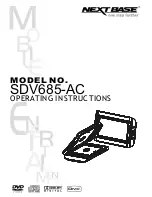
LTR-NET OVERVIEW
6-6
November 2001
Part No. 001-7240-001
•
The call is routed to a specified locality only if a call
on the home/group has been recently detected. This
results in more efficient use of system resources.
•
The call is routed to a specific locality if a tracked
unique ID is registered on that locality.
Wide area group calls can also be made over stan-
dard LTR and conventional Viking VX repeaters that
are connected to a 3000-series LTR-Net switch.
However, no other LTR-Net enhanced features are
available with those repeaters.
Wide area group calls continue to be received
while registration on a new locality occurs. For
example, the transceiver can exit a locality while
receiving a call, register on a new locality, and then
continue receiving the call on the new locality. In addi-
tion, a call can be received on the new locality before
registration occurs if the call is already active on the
new locality.
6.5 SPECIAL CALLS
6.5.1 GENERAL
LTR-Net subscriber units can place Auxiliary,
Telephone, and Data special calls. These calls are not
available to LTR subscriber units being used on an
LTR-Net system. When a special call is placed, a
number is dialed which specifies the recipient of the
call. The DTMF keypad used to dial this number may
be optional, and it is located on the microphone with
mobile subscriber units and on the front panel with
portable units. Special calls hold the channel until the
entire call is complete, not just until the transmission is
complete as with group calls. More information on
each special call follows.
6.5.2 AUXILIARY CALLS
Auxiliary calls include Unique ID and Directed
Group calls. Unique ID calls allow calls to be selec-
tively placed to an individual subscriber unit in any
locality. Likewise, Directed Group calls allow stan-
dard group calls allow group calls to be selectively
placed to any group in any locality. Refer to Section
2.9.2 for more information on these calls.
6.5.3 TELEPHONE CALLS
Telephone calls allow calls to be placed over the
public switched telephone network. After the system is
accessed, a dial tone sounds and the telephone number
being called is entered using the DTMF keypad. Since
most subscriber units are half-duplex (do not transmit
and receive at the same time), it is not possible for the
mobile user to talk and listen at the same time.
If a unique telephone number has been assigned
to subscriber unit, it can be called directly from a land-
side telephone. If not, the radio system is called and
then the unique ID of the mobile must be overdialed
similar to when a unique ID call is placed by a
subscriber unit.
If a subscriber unit has been assigned a unique
telephone number, that number can also be used for
unique ID calls. This allows mobile-to-mobile unique
ID calls to be made by simply dialing the telephone
number of the desired subscriber unit.
6.5.4 DATA CALLS
NOTE: Data calls are not currently available.
Data calls allow data to be transmitted to a
specific unique ID. The audio of the receiving equip-
ment is automatically muted as data is received. Data
may be transmitted back and forth several times until
the entire data exchange is complete because the
channel is held for the duration of the call. To transmit
a data call, a group programmed for the data special
call is selected and then the unique ID is entered,
usually automatically by the data equipment. Data
calls are received the same as unique ID calls.
6.6 HOME CHANNEL BACKUP
6.6.1 INTRODUCTION
An LTR-Net repeater locality (site) consists of up
to twenty interconnected repeaters (see Section 6.2.3).
One of these repeaters is usually designated as status
repeater and the others are designated as home
repeaters (see following). The subscriber units are
programmed with the channel numbers of these
repeaters. Data signaling can occur continuously with
















































